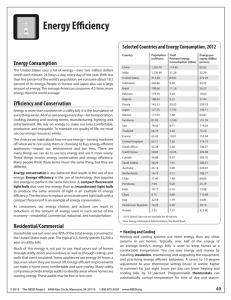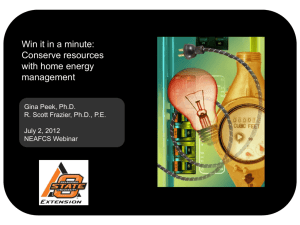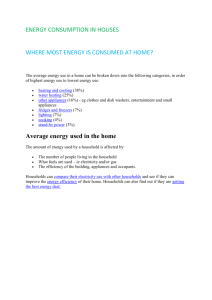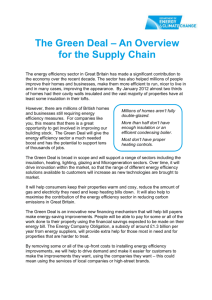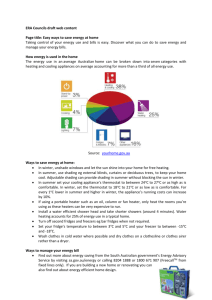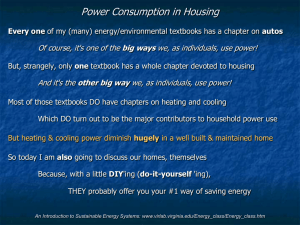Wasting energy and how to save it in our houses
advertisement
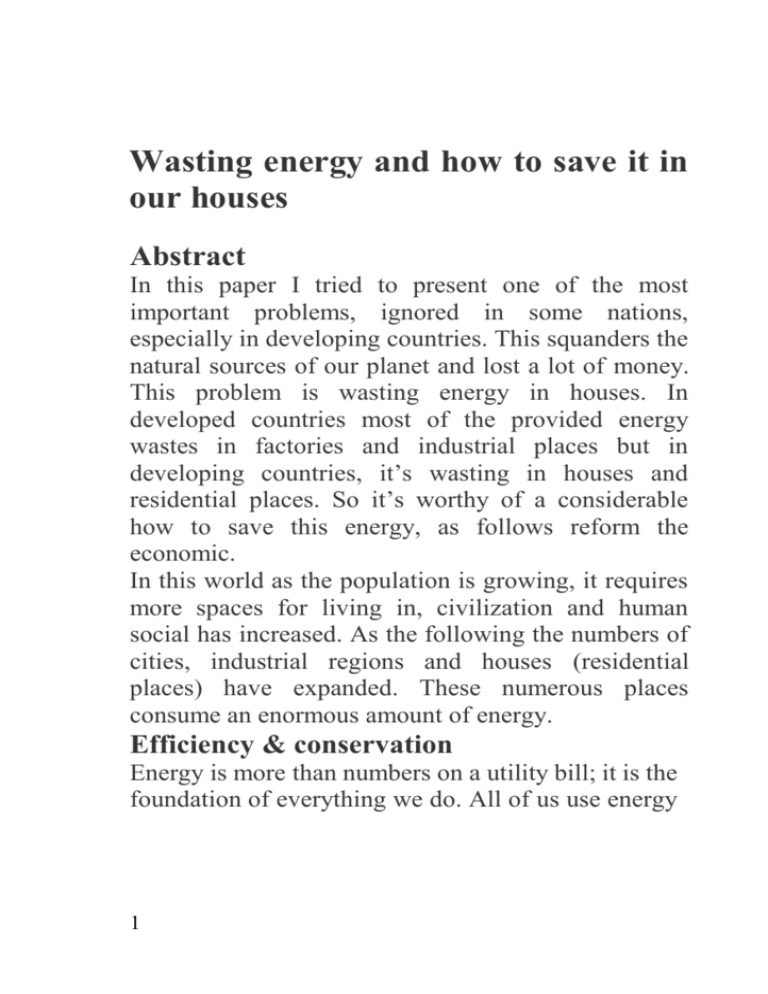
Wasting energy and how to save it in our houses Abstract In this paper I tried to present one of the most important problems, ignored in some nations, especially in developing countries. This squanders the natural sources of our planet and lost a lot of money. This problem is wasting energy in houses. In developed countries most of the provided energy wastes in factories and industrial places but in developing countries, it’s wasting in houses and residential places. So it’s worthy of a considerable how to save this energy, as follows reform the economic. In this world as the population is growing, it requires more spaces for living in, civilization and human social has increased. As the following the numbers of cities, industrial regions and houses (residential places) have expanded. These numerous places consume an enormous amount of energy. Efficiency & conservation Energy is more than numbers on a utility bill; it is the foundation of everything we do. All of us use energy 1 every day—for transportation, cooking, heating and cooling rooms, manufacturing, lighting, and entertainment. We rely on energy to make our lives comfortable, productive and enjoyable. To maintain our quality of life, we must use our energy resources wisely. The choices we make about how we use energy— turning machines off when we’re not using them or choosing to buy energy efficient appliances—impact our environment and our lives. There are many things we can do to use less energy and use it more wisely. These things involve energy conservation and energy efficiency. Many people think these terms mean the same thing, but they are different. Energy conservation is any behavior that results in the use of less energy. Energy efficiency is the use of technology that requires less energy to perform the same function. A compact fluorescent light bulb that uses less energy than an incandescent bulb to produce the same amount of light is an example of energy efficiency. The decision to replace an incandescent light bulb with a compact fluorescent is an example of energy conservation. 2 Commercial sector, houses and household equipment consume more any other economic sectors in developing countries. For example in one of these countries, this consists, 22% of Oil Prod Natural Gas and 11% of Electricity. The value of energy consumed amounted to 9.898 billion The main challenge facing is dominant non efficient sets of home app market in one hand and noncompliance's of main stream home bu principals of energy conservation on the According to one survey covering whole this country, the consum quarter meter of buildings is equivalent to 30 m3 of gas per year. T down to 20 m3 in 2020 with implementing improving programs, whic comparing to European index of 5.5 m3 of gas per year. 3 Saving energy in residential places The first important thing is the place of windows & bedrooms, as it when they place to the south will get efficient heat and energy from the sun – more in summer and less in winter. This is necessary & vital for health of the society. Another possible performance for saving energy is heating system from the floor and cooling system from the ceiling. For this we can place or fix some pipes around the floor & ceiling as radiators and fans, so it’s easier and faster than when they fix to the one side of the room for heating & cooling. Heating and Cooling Heating and cooling systems use more energy than any other systems in our homes. Typically, 71 percent of an average family’s energy bills in developing countries are spent to keep homes at a comfortable temperature. 1/5 of family’s consumed energy is spent to produce hygienic heated water. It depends on the kind of waterheater, its fuel, place of fixing and way of using it. 4 We can save energy and money by installing insulation, maintaining and upgrading the equipment, and practicing energy-efficient behaviors. A two-degree adjustment to your thermostat setting (lower in winter, higher in summer) can lower heating bills, and prevent of entering carbon dioxide to the atmosphere. Programmable thermostats can automatically control temperature for time of day and season. Insulation and Weatherization We can reduce heating and cooling needs by investing in insulation and weatherization products. Warm air leaking into our homes in summer and out of our homes in winter can waste a lot of energy. Insulation wraps our house in a nice warm blanket, but air can still leak in or out through small cracks. Often the effect of small leaks is the same as keeping a door wide open. One of the easiest ways for saving money we can do is caulk, seal, and weather-strips all the cracks to the outside. We can save money and energy by stopping the air leaks in our homes. Doors and Windows 5 About one-third of a typical home’s heat loss occurs through the doors and windows. Energyefficient doors are insulated and seal tightly to prevent air from leaking through or around them. If your doors are in good shape and you don’t want to replace them, make sure that they seal tightly and have door sweeps at the bottom to prevent of leaking the air. Installing insulated storm doors provides an additional barrier to leaking air. Most homes have many windows more than doors. Replacing older windows with new energy-efficient ones can reduce air leaks and utility bills. The best windows shut tightly and are constructed of two or more pieces of glass separated by a gas that does not conduct heat well. If you cannot replace older windows, there are several things you can do to make them more energy efficient. First, caulk any cracks around the windows and make sure they seal tightly. Add storm windows or sheets of clear plastic to the outside to create additional air barriers. You can also hang insulated drapes on the inside—during the winter, open them on sunny days and close 6 them at night. During the summer, close them during the day to keep out the sun. Landscaping Although it isn’t possible to control the weather, landscaping can reduce its impact on using of energy in homes. By placing trees, shrubs, and other landscape structures to block the wind and provide shade, people can reduce the energy needed to keep their homes comfortable during heating and cooling seasons. Electricity & Appliances Appliances account one main part of a typical household’s energy use, with refrigerators, clothes washers and dryers at the top of the list. When you are shopping for new appliances, you should think of two price tags. The first one is the purchase price. The second price tag is the cost of operating the appliance during its lifetime. Many energy efficient appliances cost more to buy, but save money in lower energy costs. Over the life of an appliance, an energy-efficient model is always a better deal. 7 Lighting We spend a lot of our electricity on lighting. Much of this energy is wasted on using inefficient incandescent light bulbs. Only 10 percent of the energy used by an incandescent bulb produces light; the rest is given off as heat. If you replace 25 percent of your light bulbs with fluorescents, you can save about 50 percent on your lighting bill. Compact fluorescent light bulbs (CFLs) provide the same amount of light and no longer flicker or buzz. CFLs cost more to buy, but they save money in the long run because they use only one-quarter the energy of incandescent bulbs and last 8-12 times longer. Also LED (light emitting diode) lamps are very good for energy saving. They’re available now. Energy sustainability Efficiency and conservation are the keys of energy sustainability––that means every generation should use its energy needs without compromising the energy needs of future generations. In fact today’s energy supplied for us is the future generation’s heritage. It’s our duty to maintain it. 8
